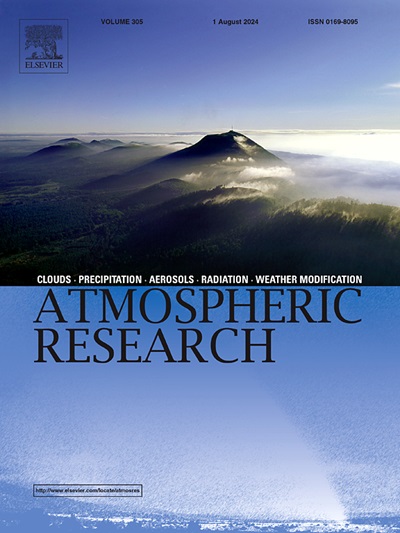通过基于机器学习的后处理修正改进风云三号三维卫星大气可降水水汽产品
IF 4.5
2区 地球科学
Q1 METEOROLOGY & ATMOSPHERIC SCIENCES
引用次数: 0
摘要
卫星遥感已成为观测可降水量(PWV)的必要手段。然而,传感器性能、算法假设和估计方法的限制可能导致卫星检索PWV的误差,从而限制了这些产品的准确性。本文分析了中国极轨气象卫星风云- 3d中分辨率光谱成像仪- ii (MERSI-II) PWV业务产品的偏置和后处理校正。首先,利用2019年5月至2020年5月的AERONET观测数据进行全球质量评估。然后,利用各种影响因素分析了产品偏差的变化。验证结果表明,MERSI-II的4种PWV产品都有不同程度的低估倾向。偏差取决于太阳天顶角、观测天顶角、太阳方位角、观测方位角、数字高程模型和归一化植被指数等因素。在偏差分析的基础上,选取影响因子,利用极值梯度增强模型对PWV产品进行后处理校正。后处理校正结果表明,PWV产品的平均偏置几乎为零,所选参数的影响最小。三通道加权乘积的相关系数为0.975,76.0%的配对落在±(0.03 + 0.1 × PWVAERONET)的预期误差包络内。这些研究结果有助于减少偏差并提高MERSI-II PWV产品的质量。本文章由计算机程序翻译,如有差异,请以英文原文为准。
Improving Fengyun-3D satellite atmospheric precipitable water vapor products through machine learning-based post-processing correction
Satellite remote sensing has become essential for observing precipitable water vapor (PWV). However, limitations in sensor performance, algorithmic assumptions, and estimation methods can result in errors in satellite retrievals of PWV, which limits the accuracy of these products. This study analyzes the bias and post-processing correction of the Medium Resolution Spectral Imager-II (MERSI-II) PWV operational products aboard China's polar-orbiting meteorological satellite, Fengyun-3D. Initially, a global quality assessment is conducted using AERONET observations from May 2019 to May 2020. Afterward, variations in the product's bias are analyzed using various influencing factors. Validation results show that the four PWV products of MERSI-II tend to underestimate values to varying degrees. Bias varies based on factors such as solar zenith angle, view zenith angle, solar azimuth angle, view azimuth angle, digital elevation model, and normalized difference vegetation index. Based on the bias analysis, factors are selected, and a post-processing correction is implemented on the PWV products using the Extreme Gradient Boosting model. Post-processing correction results show that the mean bias of the PWV products is nearly zero, with minimal impact from the selected parameters. The correlation coefficient of the three-channel weighted product is 0.975, and 76.0 % of the matchups fall within the expected error envelope of ±(0.03 + 0.1 × PWVAERONET). These research findings assist in minimizing bias and enhancing the quality of MERSI-II PWV products.
求助全文
通过发布文献求助,成功后即可免费获取论文全文。
去求助
来源期刊

Atmospheric Research
地学-气象与大气科学
CiteScore
9.40
自引率
10.90%
发文量
460
审稿时长
47 days
期刊介绍:
The journal publishes scientific papers (research papers, review articles, letters and notes) dealing with the part of the atmosphere where meteorological events occur. Attention is given to all processes extending from the earth surface to the tropopause, but special emphasis continues to be devoted to the physics of clouds, mesoscale meteorology and air pollution, i.e. atmospheric aerosols; microphysical processes; cloud dynamics and thermodynamics; numerical simulation, climatology, climate change and weather modification.
 求助内容:
求助内容: 应助结果提醒方式:
应助结果提醒方式:


